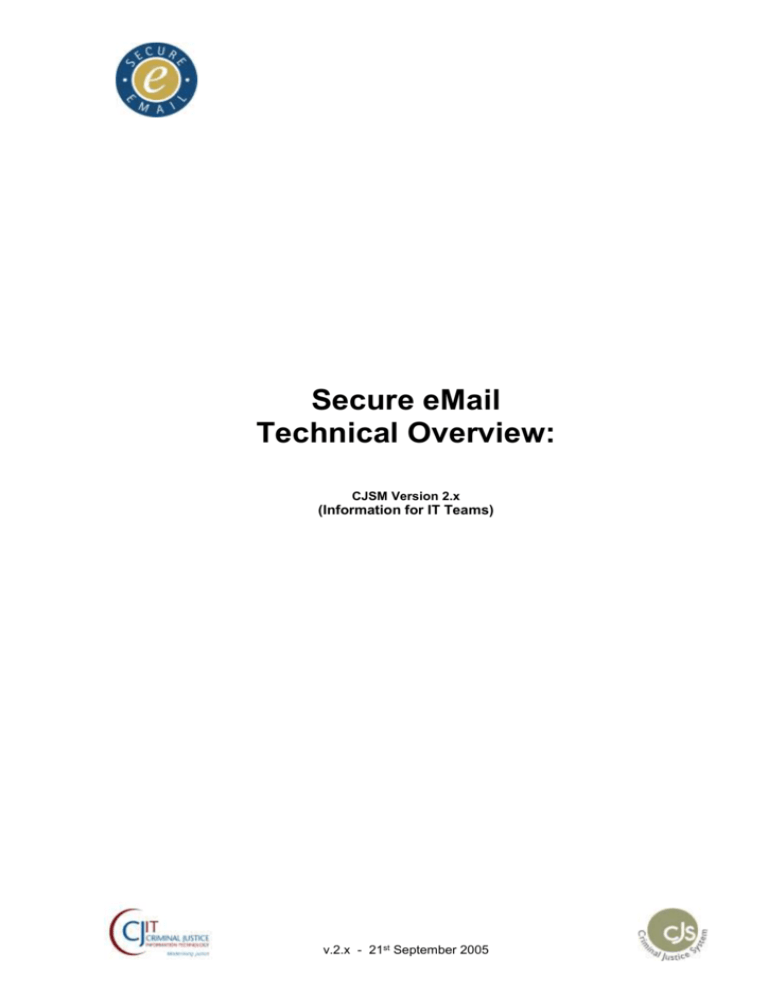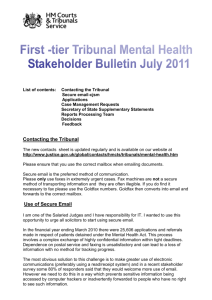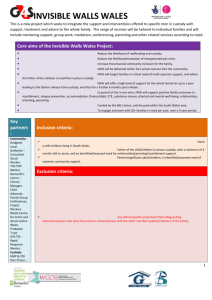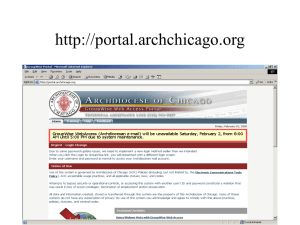`Separated` CJSM server
advertisement

Secure eMail Technical Overview: CJSM Version 2.x (Information for IT Teams) v.2.x - 21st September 2005 Technical Overview: CJSM Version 2.x 20-Sep-2005, Vsn1.0 SUMMARY Criminal Justice Secure eMail (CJSM) provides a national email service between Criminal Justice Agencies (CJAs) and Criminal Justice Practitioners (CJPs), which is sufficiently secure to handle material bearing a RESTRICTED protective marking, or similarly sensitive information. CJSM allows agencies or Organisations not connected to the GSC (Government Secure Community) to exchange unstructured messages (email) to agencies within the GSC. Examples of CJA’s within the GSC are Police, Prison Service, Court Service, CPS & Probation. Examples of agencies/CJP’s outside the GSC who are expected to be the prime beneficiaries of CJSM are Yots, Victim Support, solicitors & barristers. This paper describes the methods by which non-GSC agencies/CJP’s can connect to CJSM via a standard internet connection. This document is particularly relevant to IT suppliers (e.g. Local Authority IT department). GLOSSARY LDAP POP3 SMTP Lightweight Directory Access Protocol Post Office Protocol (version 3) Simple Mail Transfer Protocol SSL (v3) Secure Sockets Layer (version 3) TLS HTTP HTTP S SMTP AUTH DNS LAN RFC Transport Layer Security HyperText Transfer Protocol HTTP Secure Domain Name System Local Area Network Request For Comment An Internet standard technical specification CJIT CJSM DCA GSC GSI GSX CJX PNN2 Criminal Justice IT Criminal Justice Secure eMail Department for Constitutional Affairs Government Secure Community Government Secure Intranet Government Secure Extranet Criminal Justice Extranet Police National Network (version 2) this is the branding used on the portal (not SeM) formerly Lord Chancellor’s Department = GSI/GSX/CJX used by most central government departments used by the probation service, amongst others used by the police and others (hosted by PNN2) used by police forces Authenticated SMTP for distribution of directory information for download of messages by email clients for upload of messages to email servers, and for relaying of messages between servers a means of encrypting communications between two computers (e.g. email client and its server) and authenticating both parties the Internet standard version of SSLv3 (“SSL 3.1”) for communication with web servers a secure version of HTTP, using SSL a version of SMTP which authenticates the client sending email (NB: plain SMTP is trivial to spoof) 'RESTRICTED' is a level of security within the Government Protective Marking Scheme as defined in the MPS (Manual of Protective Security) Technical Overview CJSM 2.x Version 1.0 Page 1 of 15 OVERVIEW Criminal Justice Secure eMail (CJSM) provides a national email service between Criminal Justice Organisations (CJAs) and Criminal Justice Practitioners (CJPs), which is sufficiently secure to handle material bearing a RESTRICTED protective marking, or similarly sensitive information. The overall CJSM programme is being managed by Criminal Justice IT (CJIT). CJSM does not provide “secure email” in the sense in which that phrase is normally used. The messages themselves are neither signed nor encrypted1. It isn’t altogether concerned with end-to-end security in any case; rather, with providing a level of security for messages conveyed between organisations (via the Internet) equivalent to that provided within the existing GSC. User access (i.e. a secure email address and the associated username and password) is only granted to users within the GSC, or to those organisations and users individually registered with CJSM. To be registered, organisations (and users) must meet the requirements of a Terms and Conditions, which are designed to certify that security technology, policy and practice within the relevant local network eg. Local Authority are roughly equivalent to those which pertain within the GSC. Mirapoint (a US company) provided the initial setup but Cable & Wireless now hold full design authority for the entire solution, including the directory and portal with associated development work. The portal is managed and operated by CW at a secure hosting facility shared with other GSC services, which are also under CW management. 1 In fact, they cannot be signed or encrypted. Modifications made to the message in transit across CJSM mean that the message digests (think of these as checksums or fingerprints of the original message) used to calculate the original keys would not match those of the message received. Signature verification would fail, and decryption of the message would be impossible. This behaviour is understood and it is by design. Technical Overview CJSM 2.x Version 1.0 Page 2 of 15 TECHNICAL OVERVIEW As the internet is not deemed secure enough to carry RESTRICTED this information must be encrypted to at least 128-bit level encryption. CJSM offers 2 mechanisms of connection that support this encryption: mailbox or server. For the mailbox solution CJSM hosts a mailbox on behalf of the user. A user accesses the mailbox via either a standard internet browser or a POP3 email client. In both cases a 128-bit SSL connection is established point-to-point from the client machine to the portal (www.cjsm.net) For the server connection, a server (the 'CJSM server') is deployed to act as an encryption proxy for any email traffic containing a destination address ending in 'cjsm.net'. CJSM mail routing is a '2-hop' process - all outbound mails are routed first via the central 'cjsm.net' hub before being routed directly to their final destination. The CJSM server will usually be located in the DMZ but it is at the discretion of each Remote Organisation where this server is located. ‘Separated’ (see later) CJSM servers will run Windows 2000/2003 Server configured using SMTP/IIS as an SSL encryptor/decryptor and mail relay. ‘Co-located’ (see later) CJSM servers can also run SMTP/IIS, usually over an existing MS Exchange or Lotus Notes installation, as an SSL encryptor/decryptor and mail relay. Other mail products can operate in co-located mode. In either case, dual-authenticated SSL/TLS is used to establish SMTPS connections over the internet and to encrypt traffic between the CJSM server and the hosted cjsm.net server. To do this all CJSM servers require a certificate issued by CW to be installed. Session keys are established for each transaction Technical Overview CJSM 2.x Version 1.0 Page 3 of 15 CONNECTION TYPES Upon an Organisation meeting a set of security requirements CJSM can accept connections at a server-to-server (or ‘server’) level from non-GSC CJAs and their subsidiaries. GSC organisations automatically qualify for a server connection with no technical effort required since CJSM has a builtin link via GSX already to these organisations. In all server cases CJSM acts as a secure mail relay ie. no persistent message storage is required at CJSM. In the event a connecting Organisation is unable or unsuited to a server connection CJSM also provide hosted mailboxes. Such mailboxes can be accessed via a webmail browser interface or a POP3 client. For the webmail interface, although more secure, the interface is similar to a hotmailtype account. Connection types: Detailed discussion As stated above there are two mechanisms to connect to CJSM – Server or Mailbox. (An exhaustive list of the pros and cons of server vs webmail is contained in Appendix B of this document) These two solutions can be split into sub-types : Server Option a) A ‘separated’ CJSM server: physically separate the server running the software required to handle CJSM traffic from the server that handles all normal traffic for an Organisation (eg. a box running IIS/SMTP only) b) A ‘co-located’ CJSM server: co-locate the software required to handle CJSM traffic on the same server that handles all normal traffic for an Organisation (eg. EXIM mail relay, Exchange, Notes, Groupwise) Mailbox o Webmail: a browser-based interface to a CJSM hosted mailbox o POP3: a thick client eg. Outlook connection to a CJSM hosted mailbox Server For a variety of reasons, but mainly from a key management perspective, it was considered too onerous to issue keys/certificates at an individual user level. Therefore those non-GSC Organisations opting for a server connection will be issued a single CW certificate which encompasses the whole domain eg. all users bearing a @lambeth.gov.uk email address. Each CW certificate is valid for 3 years. For the purposes of assessing the implementation tasks a high level task list for deploying a server solution is supplied in Appendix A of this document. In the server solution all outbound messages are directed to a central messaging hub (domain=cjsm.net) en-route to their destination. Between the hub and each CJSM server, an SSL/TLS session is established for each message before it is transmitted down the encrypted pipe. Therefore the CJSM server acts only as SSL/TLS encryptor/decryptor and mail relay. A similar process happens when CJSM delivers the message to its destination (if the destination is outside the GSC). cjsm.net will manage addressing, routing and the re-writing of the message headers to ensure that the message follows a secure path, that the return address is secure and that final delivery of both regular and secure email to server-connected users is to one inbox (to avoid people having to look in two places). The following describes the process flows :Process flow inbound to Remote Organisation from cjsm.net: cjsm.net SMTP server initiates SMTP over SSL/TLS connection direct to CJSM server passing through the Remote Organisation’s external firewall. IP address resolution at cjsm.net occurs by an internal smart-host lookup which matches Remote Organisation’s email domain to the supplied IP address CJSM server accepts connection and decrypts incoming mail message Technical Overview CJSM 2.x Version 1.0 Page 4 of 15 CJSM server relays (now decrypted) mail message to an internal server as designated by the Remote Organisation. Typically this is either the incoming interface of non-secure mail-pointof-entry server eg. MailSweeper or the next server in the chain to this for an incoming mail flow eg. anti-virus server in DMZ or Exchange bridgehead located on internal network Process flow outbound from Remote Organisation to cjsm.net: Mail (initiated at a Remote Organisation mail client) destined for a “cjsm.net” recipient is filtered out from the non-secure email routing and re-routed to the CJSM server. Which server this takes place at is at the discretion of the Remote Organisation but typically this will be at mail-point-of-entry server eg. MailSweeper or the last mail bridgehead server CJSM server initiates SMTP over SSL/TLS connection direct to the cjsm.net SMTP server Virus Scanning All messages outbound and inbound (including attachments) during an SMTP-to-SMTP transaction through cjsm.net are subject to an Government accredited virus scan. Signature file updates are updated on demand. For a server solution the following tasks required of the Remote Organisation’s IT staff : supply a static public IP address that is routable to the server designated as the CJSM server preparation: read background, decide changes required to production system and formally change control them if required if a new server, build server to Remote Organisation standard build configuration load and configure the SMTPS software (IIS/SMTP Relay on Windows 2000/Windows 2003). A detailed configuration document is available for this purpose if a new server, join server to perimeter network and internal network (for onward delivery of email) generate Certificate Request, submit it to CW and install the certificate when it is returned perform any necessary firewall changes (the required ports [TBA due to security restrictions] open inbound from 'saturn.cjsm.net' & outbound to 'smtp.cjsm.net') perform any necessary point-of-entry server eg. MailSweeper changes to filter *cjsm.net traffic install certificate & liaise with CJSM Helpdesk to troubleshoot any issues perform an initial load of a customized 'cut-down' version of the CJSM Directory onto native mail system (eg. CSV import). Maintenance of this directory beyond this point will be reviewed at a later date ‘Separated’ CJSM server: Where a server solution has been identified (and approved) as the preferred solution, and your Organisation is large, we recommend the deployment of a Separated CJSM server. By ‘separated’ we simply mean physically separate the server running the software required to handle CJSM traffic from the server that handles all normal traffic for an Organisation. The server that handles all normal traffic for an Organisation is normally the server pointed to by the MX record for each organisation. The reasons for this are :1. Practicality At the time of writing, in the majority of larger IT infrastructures the mail-point-of-entry server (the box to which the public MX record points) cannot support a SSL/TLS connection. It is normally a mail relay/content scanner/anti-virus server running software such as MailSweeper. Current versions of MailSweeper (and software which performs similar operations) generally do not support a SSL/TLS connection and as this is a pre-requisite for connecting to the CJSM service, a separated server which can perform this function will be required in the majority of cases. The alternative to this is to by-pass the mail-point-of-entry server altogether and port forward on the firewall directly to an internal server which is capable of supporting SSL/TLS (eg. Exchange, Notes). This is not recommended from a security viewpoint 2. Business Continuity Even if the mail-point-of-entry server is capable of supporting a SSL/TLS certificate, installing a certificate on a server through which existing non-secure email flows introduces a risk to the Technical Overview CJSM 2.x Version 1.0 Page 5 of 15 current mail service. Remote Organisations can choose to opt for this, but they do so at their own risk of an email disruption 3. Repeatability and Support Deploying 90%+ of one solution is a more reliable, more speedy, less complex & more supportable process than deployments onto the many varied flavours of hardware and software that could potentially exist in Remote Organisations. The installed server base currently existing on CJSM, and hence the 2 nd line support available, is more heavily slanted towards the separated CJSM server approach NB. Although we recommend a separated CJSM server for larger Organisations this does not necessarily mean that a dedicated or new server must be used for the CJSM Server. Existing hardware can be used. Recommended hardware and software : The CJSM server acts only as SSL/TLS decryptor and mail relay therefore the minimum disk size has been selected. Being dependent on service take-up throughput is harder to estimate but even high-end estimates of traffic indicate that this server specification will be more than adequate. A recommended hardware specification would be : Rack mounted (normally 1U) device, mirrored 18.6 GB disks, 1GB SDRAM, 2x NIC cards (no monitor) Windows 2003 running IIS/SMTP relay (Windows 2000 is supported also) ‘Co-located’ CJSM server Examples of mail-point-of-entry servers that can support a SSL/TLS certificate are EXIM mail relay, Exchange, Notes or Groupwise, Trend Interscan. The advantage of this solution is cost: no hardware costs, no software costs, minimal implementation costs and no additional annual managed server costs. The disadvantage of this solution is the lack of support for SSL/TLS for the most common mail-point-of-entry servers eg. MailSweeper so in most cases it will simply not be a viable solution. In addition, even if the mail-point-of-entry server is capable of supporting a SSL/TLS certificate, installing a certificate on a server through which existing non-secure email flows introduces a risk to the current mail service. As previously stated Remote Organisations can choose to opt for this, but they do so at their own risk of an email disruption. It should be noted though that a properly planned back-out procedure should mitigate the risk of outages Webmail: Webmail requires only a standard browser (subject to browser setup policy/version supporting (minimum) 128-bit HTTPS connections) and a suitably capable internet connection. Webmail uses a password-protected webmail interface (browser, HTTP). These passwords are never transmitted “in clear” across the wire. POP3 access to a CJSM mailbox can be supported and requires a new profile to be added for every user. CJSM provides scripts to assist with this for Outlook Express clients Virus Scanning All messages outbound and inbound (including attachments) sent to or from a CJSM mailbox are subject to an Government accredited virus scan. Signature file updates are updated on demand. Technical Overview CJSM 2.x Version 1.0 Page 6 of 15 ACCREDITATION The CJSM service is accredited to a level of ‘Criminal Justice RESTRICTED’. It is allowed to connect to the wider GSC through an interconnect to the GSX network SUPPORT Post-implementation support will be shared between each Remote Organisation and the CJSM Helpdesk. Only in the event of webmail user forgetting (or locking) their password should an end user ever contact the CJSM Helpdesk directly. (Users behind a server connection ie. a local mailbox will never require their CJSM passwords to send/receive mail). In all other instances where there seems to be a problem using the CJSM service, users should follow local IT helpdesk procedures. For administration issues, or possibly to assist with some technical issues, it may be desirable for the OA to contact the CJSM Helpdesk directly. It is each Remote Organisation IT Helpdesk's responsibility to maintain an acceptable service for CJSM users. This means that for a webmail solution the Remote Organisation has responsibility for maintaining a HTTPS connection from the user’s browser out to the internet. It is important to note that CW responsibility ends at the boundary of their hosted service, therefore for a server solution this means that the Remote Organisation has responsibility for maintaining the internal mail system, firewall and internet service as well as the hardware, OS and software associated with the CJSM Server. Only when it has been established that the loss of CJSM service is not due to a local service provision problem (eg. Mail Server outage, Remote Organisation server outage/network issue/ISP service loss) should the Remote Organisation IT Helpdesk contact the CJSM HelpDesk. Each Remote Organisation, whether webmail or server, is requested to nominate a group IT Helpdesk mail account that will have access to the CJSM mail service. This account serves 2 purposes : to send or receive fault diagnostic/resolution messages to receive important system updates from CJSM eg. re-certification, system patches, service information, system outage All CJSM related queries should be directed to the CJSM Helpdesk. Contact details and hours of service are :CJSM Helpdesk Tel: Email: CJSM Helpdesk hours of operation 0870 010 8535 cjsm.helpdesk@cw.com 8am - 7pm Monday - Friday SECURITY In general secure email services should provide four generic capabilities. confidentiality (assurance that a message cannot be read in transit) integrity (assurance that a message cannot be altered in transit) authentication (assurance that the sender and recipient are whom they purport to be) non-repudiation (prevention of sender or recipient denying a message once sent) For GSC users (which covers most of the CJAs), the existing email service is deemed secure. For other users, where communications rely on the Internet, CJSM provides an “encrypted tunnel”, through which RESTRICTED or otherwise sensitive email can be conveyed securely (rather than using unprotected and potentially unsafe Internet connections). This safeguards the confidentiality and integrity of the information conveyed between organisations across CJSM. Technical Overview CJSM 2.x Version 1.0 Page 7 of 15 For authentication, CJSM requires webmail users to login with individual username/password combinations. Users with a server-level connection to CJSM will be authenticated by local systems (by pass-through login from a trusted operating system such as Windows XP). Finally, CJSM supports delivery receipts (at least to the extent that the email systems connected to it do so). Combined with integrity and authentication, this arguably addresses non-repudiation. More technically, the following technologies are used. SSL/TLS is used to authenticate server-to-server connections over the Internet and to encrypt traffic between them. This requires a certificate signed by CW and installed on the (nonGSC) CJA or CJP’s mail server. SSL/TLS is not used within the GSC, which is itself secure. SSL/TLS is also used, across the Internet, between the webmail client and the CJSM Web Portal (using HTTPS). However, client certificates are not required. So, it is important to realize that within an office network (i.e. on the user’s side of a local email server), or on an individual PC, there is no additional protection offered by CJSM: the service will be as secure or insecure as the local technology and practice (except that practice may well have been tightened to satisfy the Terms and Conditions). For example, messages stored on a PC will not be encrypted on disk; if connections between PC email clients and the local email server do not use SSL/TLS, messages could be vulnerable on the wire within the LAN. SSL Certificates SSL certificates will be required for all Remote Organisation servers connected to CJSM. Certificates will be supplied (and signed) by Cable and Wireless, on authorisation by CJIT. (An SSL session will be established that uses a minimum session key length of 128 bits) Client certificates are not required for mailbox access. Username and password over SSL/TLS is deemed secure enough. Technical Overview CJSM 2.x Version 1.0 Page 8 of 15 DIRECTORY Email addresses for CJSM users (NB: not all GSC email users) will be held in an LDAP directory. The directory will contain structured information on people and on the organisations to which they belong: fields include firstname, lastname, telephone number, geographical location and email address. The directory will be accessible in several ways: for webmail users: via the www.cjsm.net website, for one-off directory enquiries; for server users: via an Address Book located locally within the Remote Organisation (NB. Not all Remote Organisation’s will be receiving updates of the CJSM Directory. It is intended to review the Directory update process soon after launch of CJSM v2.x) Addressing – individual users Individual mailbox users will get addresses of the form secure email address firstname.lastname@orgname.cjsm.net for example secure email address Susan.Smith@luton.cjsm.net The precise address format (e.g. the ‘Luton’ portion) will be defined locally, but may be overwritten by the CJSM administrator where necessary. (N.B. Mailbox addresses issued befor November 2005 will be in the form FirstnameLastnameOrganisation@cjsm.net) Users with server connections to CJSM will use their existing email clients to communicate securely with CJSM. Users wishing to send to these recipients will either select them from their local CJSM Address Book (which will contain their .cjsm.net suffix) or, if they are known to the sender, then the sender can simply append .cjsm.net to their regular email address. For example: regular email address jane.brown@kent.gov.uk secure email address jane.brown@kent.gov.uk.cjsm.net GSC users can simply use their existing email addresses to communicate securely within the GSC. For incoming mail from other CJSM users the GSC user’s address should carry the .cjsm.net suffix, to ensure that replies are routed securely. regular email address peter.smith@hmps.gsi.gov.uk secure email address peter.smith@hmps.gsi.gov.uk.cjsm.net CJSM will manage addressing, routing and the manipulation of message headers to ensure that the message follows a secure path, that the return address is secure and that final delivery of both regular and secure email to server-connected users is to one inbox (to avoid people having to look in two places). It is important to note that no changes/additions to internal mail system addresses need take place at the Remote Organisation to support a .cjsm.net address a shown above. Mail destined for a user who sits behind a server connection will have the .cjsm.net stripped from its To: address before it leaves cjsm.net. Similarly the From: address will have a .cjsm.net suffix added to enable secure reply-to For example, a message from a Kent Yot worker (server user) to a Surrey Police officer might look like: Entering the CJSM hub: To: peter.smith@surrey.pnn.police.uk.cjsm.net From: jane.brown@kent.gov.uk Leaving the CJSM hub: To: peter.smith@surrey.pnn.police.uk From: jane.brown@kent.gov.uk.cjsm.net Addressing - group mailboxes Technical Overview CJSM 2.x Version 1.0 Page 9 of 15 As well as personal user addresses, group mailboxes can also be used to handle secure email. Indeed the use of group mailboxes rather than individual addresses is encouraged on the service and an ex-directory function is available to Administrators for the ‘hiding’ of individual addresses. Addressing - populating the directory upload file Instead of adding individual users to CJSM, the Web portal allows for a batch of new users to be added in one go via the ‘Bulk Add Users’ facility available to Organisational Administrators Technical Overview CJSM 2.x Version 1.0 Page 10 of 15 REFERENCES Additional information is available on the CJIT website at www.cjit.gov.uk. Pertinent Internet standards can be found at http://www.imc.org/rfcs.html. They include: RFC 2821 Simple Mail Transfer Protocol RFC 3207 SMTP Service Extension for Secure SMTP over Transport Layer Security RFC 1939 RFC 2595 RFC 2251 RFC 3377 Post Office Protocol - Version 3 (POP3) Using TLS with IMAP, POP3 and ACAP Lightweight Directory Access Protocol (v3) Lightweight Directory Access Protocol (v3): Technical Specification It is not necessary to be familiar with these documents to implement the CJSM service Technical Overview CJSM 2.x Version 1.0 Page 11 of 15 Appendix A. High Level task list for a ‘separated’ CJSM Server supply a static public IP address for the CJSM server. IP address supplied (for incoming connections) must match that presented on outbound connections from Remote Organisation state whether any fixup protocols are being deployed on firewalls (or any other issue) that would prevent the passing of a STARTTLS command on the required port [TBA due to security restrictions] preparation: read background, decide changes required to production system and formally change control them if required build server to Remote Organisation standard load and configure the SMTPS software (IIS/SMTP Relay on Windows 2000/Windows 2003) join server to perimeter network and internal network (for onward delivery of email) generate Certificate Request, submit it and install the returned certificate perform any necessary firewall changes (the required ports [TBA due to security restrictions] open inbound from 'saturn.cjsm.net' & outbound to 'smtp.cjsm.net') perform any necessary point-of-entry server eg. MailSweeper changes to filter *cjsm.net traffic install certificate & liaise with CJSM Helpdesk to troubleshoot any issues (status = Tech Live) (optional) create and/or make available Group Mailboxes (as additional mailboxes) to CJSM users perform an initial Address Book Population (ABP) of 'cut-down' version of the CJSM Directory onto native mail system (eg. CSV import) (status = Business Live) agree an ongoing refresh strategy for maintaining ABP current re-certification process (every 3 years). [generate Certificate Request, submit it and install the returned certificate] Technical Overview CJSM 2.x Version 1.0 Page 12 of 15 Appendix B. Pros v cons: server vs mailbox A server solution is defined as: an encryption proxy for any email traffic containing a destination address ending in 'cjsm.net'. CJSM mail routing is a '2-hop' process - all outbound mails are routed first via the central 'cjsm.net' hub before being routed directly to their final destination. The CJSM server will usually be located in the DMZ but it is at the discretion of each Remote Organisation where this server is located inbound from the internet the CJSM server decrypts mail and relays unencrypted mail onto exisiting mail bridgehead server or existing content scanning or existing anti-virus server outbound to the internet any mail destined for @cjsm.net will be filtered out and routed to the CJSM server upon where an encrypted mail transfer will be set up Server connection: Advantages: 1. Single user mailbox for managing all email, secure and non-secure 2. Single sign-on to mail 3. All incoming email can be passed through any existing perimeter checks 4. User transparency (no new email system to learn) 5. Auto-polling for mail: mail arrives automatically with no need to refresh fro new mail 6. Use in non-secure environment eg. internet café, not physically possible 7. Control. Policy checks can be enforced 8. Email addresses are simpler to remember (simply add ‘.cjsm.net’ to current ‘.gov.uk’ address if mail is to be sent securely) 9. Can work offline 10. Group mailboxes (where supported by the mail system) can be used as a means of providing generic business mailboxes providing major business benefits. No change to current working practices if replies to Group Mailbox mail is addressed from the individual not the Group Mailbox address Disadvantages: 1. Ongoing management: Potential annual cost of maintaining/supporting an additional server in the DMZ (average cost is in the region of £1500 - £2000 but this must be discussed with your IT Dept.). Directory update process - requires a regular (once per week/month?) manual upload by Remote Organisation IT Mail administrator – which many may find onerous 2. More complex and costly implementation. Does it justify the number of staff it will benefit? : extra server – potentially but not mandatory separate routing required of secure mail both in & out overhead for setup and configuration change control – implementing a server solution is a project must bypass external 3rd party AV/content scanning eg. MessageLabs more restrictive network security requirements to achieve CJIT Connection Approval addition rulesets to be set up on firewall 3. SSL certificate expiry 4. Single point of failure 5. More control therefore more culpability 6. Potential security problem if mail traversing internal microwave WAN links Webmail connection: Advantages: 1. Ease of implementation. Virtually no work required by IT staff. Quick 2. Clear demarcation lines: one email system for RESTRICTED data, one for normal mail (analogous to existing print & fax process) effectively removing the risk of RESTRICTED mail being sent to insecure personnel 3. No ongoing management overhead for Remote Organisation IT staff 4. Point-to-point security. HTTPS all the way to the desktop Technical Overview CJSM 2.x Version 1.0 Page 13 of 15 5. Can be used over microwave links that are not encrypted 6. Encrypted over LAN 7. Preferred solution if there is any embargo on network changes due to major network upgrades etc Disadvantages: 1. Another email system to learn 2. Another email address: another username/password to remember; ugly addressing 3. Interface will never be as feature-rich as say Outlook, Notes 4. Have to be online to use 5. Usability issues 6. A temporary mail storage solution: only 25 MB mailbox storage with no nested foldering 7. Requires internet access (if not available currently then this is a disadvantage) 8. Internet café use only prohibited by policy not by technology 9. Remote Organisations may not give access to the internet to all staff 10. Internet access often restricted to standalone PCs making it difficult to work with the users’ own data 11. Some Remote Organisations do not allow portal-based mail systems to be accessed from their machines 12. All incoming email cannot be passed through any existing content scanning/AV local to the Remote Organisation 13. Lack of control. No policy checks possible. 14. Have to manually poll for email. No alert to inform that mail is waiting 15. When a secure email user leaves the organisation account suspension is normally the domain of central IT. However deleting a webmail user will be an Organisational Administrator task ie. not central IT therefore there is a business risk that the organisational administrator may not follow the user deletion process 16. Not possible to forward secure emails to colleagues internal (i.e. not over the open internet) email accounts making work management more difficult especially in respect of generic mailboxes 17. More difficult to migrate to a GSI connection if Remote Organisation is considering this option Technical Overview CJSM 2.x Version 1.0 Page 14 of 15







